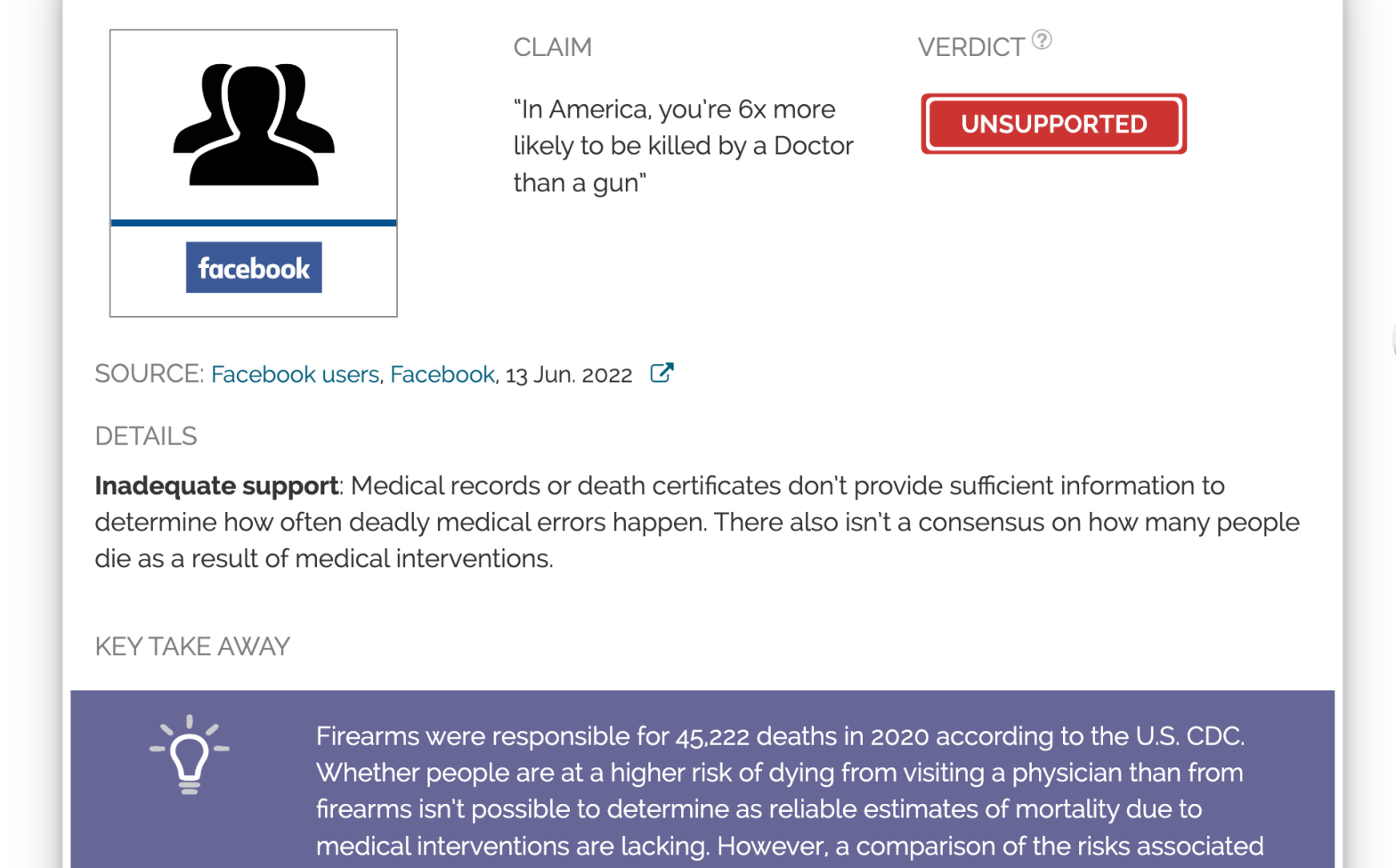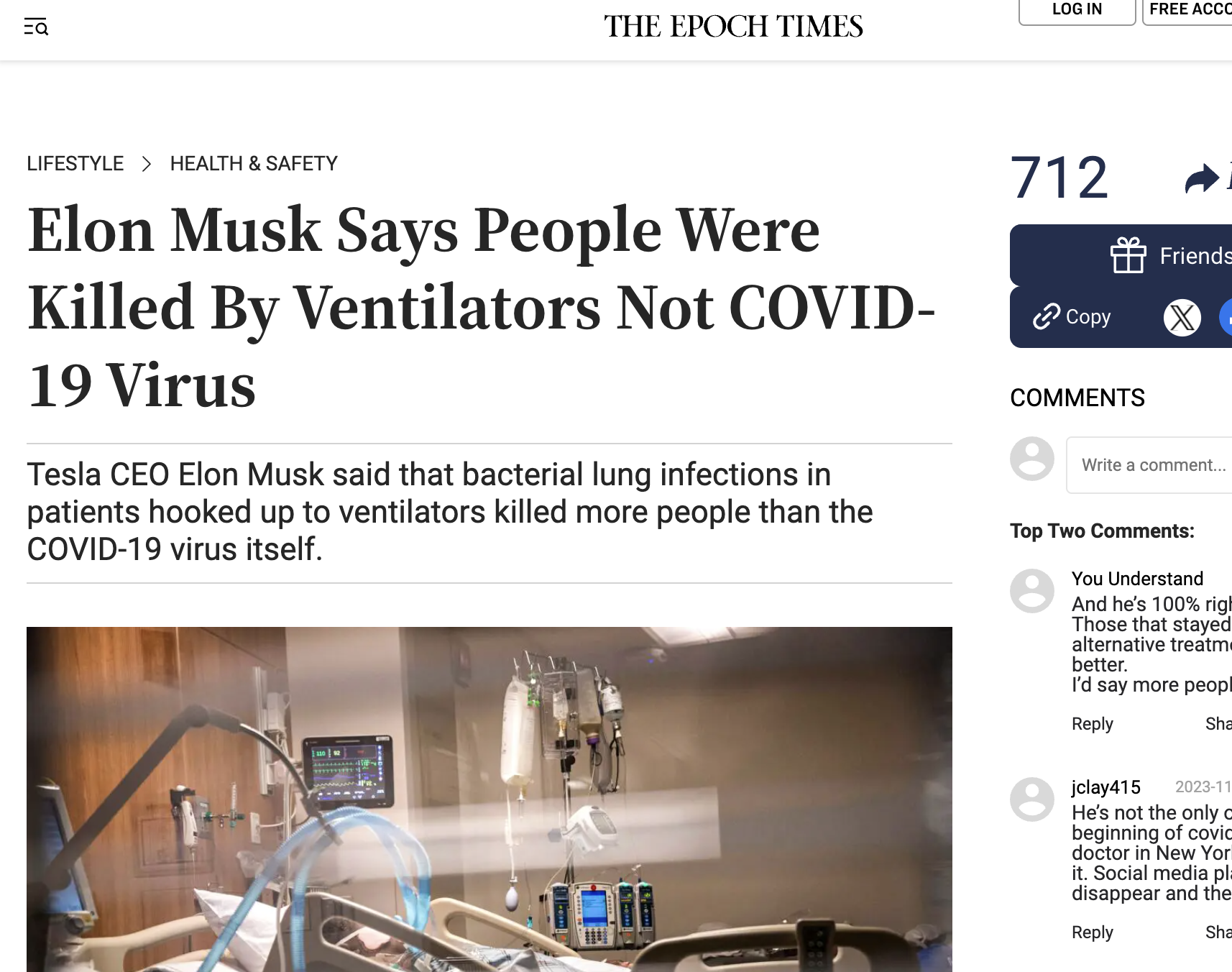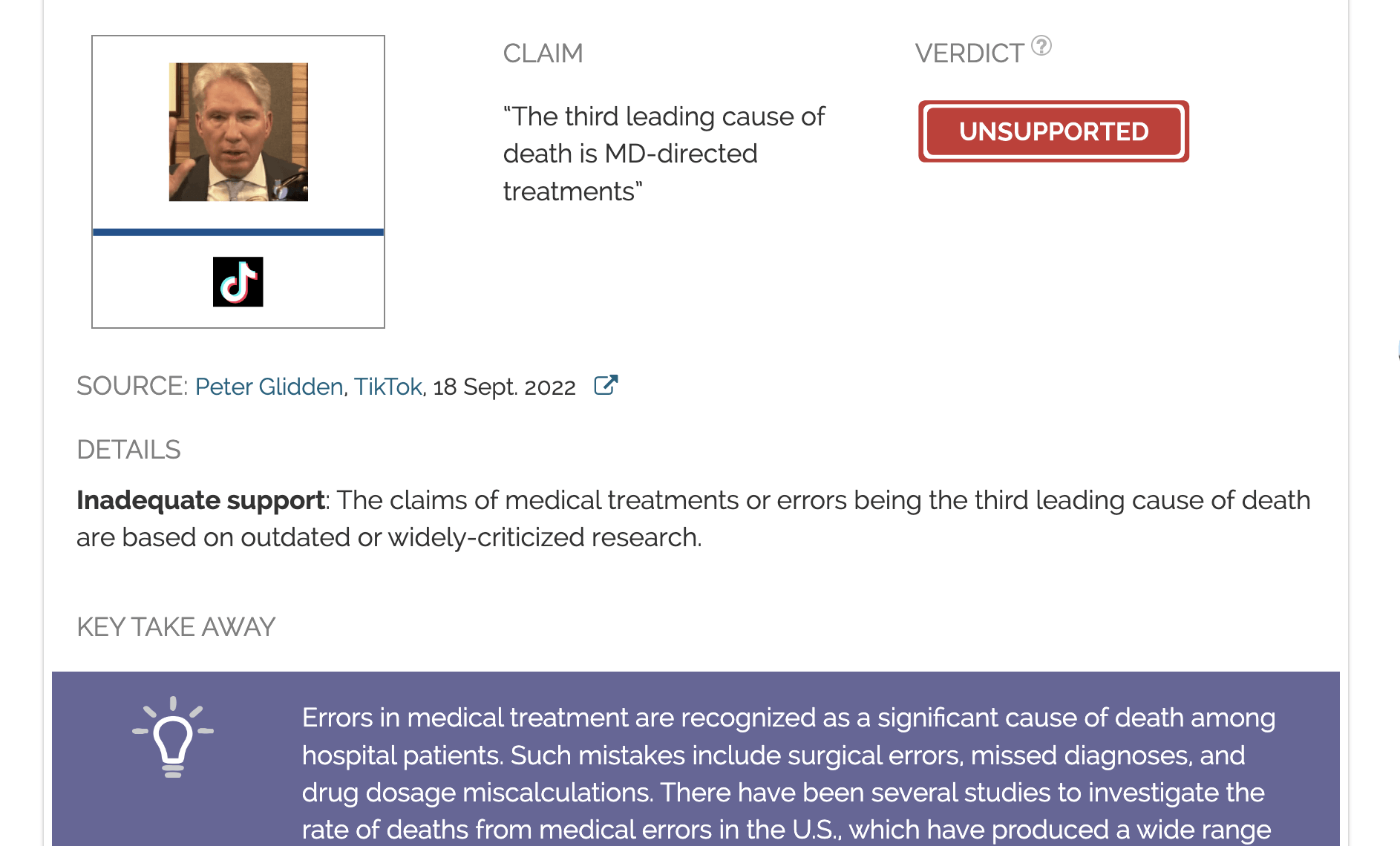- Health
The claim that medical doctors are more likely to kill than firearms isn’t supported by evidence
Key takeaway
Firearms were responsible for 45,222 deaths in 2020 according to the U.S. CDC. Whether people are at a higher risk of dying from visiting a physician than from firearms isn’t possible to determine as reliable estimates of mortality due to medical interventions are lacking. However, a comparison of the risks associated with firearms and medical care need to account for the benefits that medicine undoubtedly offers by way of improving people’s health and life expectancy over the centuries.
Reviewed content

Verdict:
Claim:
“In America, you’re 6x more likely to be killed by a Doctor than a gun”
Verdict detail
Inadequate support: Medical records or death certificates don’t provide sufficient information to determine how often deadly medical errors happen. There also isn’t a consensus on how many people die as a result of medical interventions.
Full Claim
“In America, you’re 6x more likely to be killed by a Doctor than a gun”
Review
Recurrent mass shootings in the U.S., such as the Uvalde school shooting in June 2022, once again drew the attention of both American and international media on the issue of firearm-related deaths. Unsurprisingly, posts and commentaries on social media surrounding the debate on the dangers of firearms have also gone viral. One example is this meme posted on Facebook, claiming that “In America, you’re 6x more likely to be killed by a Doctor than a gun”.
In other words, the meme claimed that one is more likely to die from medical care than from firearms. The origin of this claim is likely a publication by the National Rifle Association (NRA) in the U.S., which alleged that more people die from “medical misadventures” than firearm accidents nationally. The claim by the NRA explicitly focused only on medical errors and firearms accidents, and the meme appears to echo the same language. However, the meme also differs from the original claim by the NRA, as its language could also be interpreted to refer to all deaths due to adverse events from medical care, whether they are errors—defined as adverse events that are preventable—or not.
Specifically, adverse events are defined as “an injury that was caused by medical management (rather than the underlying disease) and that prolonged the hospitalization, produced a disability at the time of discharge, or both.” Medical errors are defined as adverse events from medical care that were preventable.
However, there’s no evidence that supports the claim in the meme and the comparison is overly simplistic. Firstly, there isn’t a strong consensus on the estimated number of deaths due to medical adverse events, therefore there’s no data to support such a comparison. Secondly, a direct comparison of mortality from firearms and preventable or non-preventable adverse events doesn’t capture the notion of “risk”, as we explain below.
Estimates of mortality due to medical care vary greatly depending on the analysis methodology
In order to compare the risk of dying from firearms or adverse events due to medical care, it is first necessary to determine how many people die from each cause each year in the U.S.
The U.S. Centers for Disease Control and Prevention (CDC) estimated the number of deaths involving firearms in 2020 at 45,222. This estimate is based on the analysis of the underlying cause of death as written on death certificates.
Death certificates list the whole chain of events leading to the patient’s demise, starting with the underlying cause of death, defined as “the disease or injury which initiated the train of events leading directly to death, or the circumstances of the accident or violence which produced the fatal injury.” The underlying cause of deaths are coded according to the International Classification of Diseases (ICD) database, which lists all the potential events that may lead to someone’s death, including firearms.
We can therefore conclude that there were 45,222 death certificates in 2022 where the underlying cause of death belonged to one of the ICD categories involving firearms. Searching on the CDC WISQARS database, which contains all the information from death certificates where the underlying cause of death was an injury, we found that there were 679,443 deaths by firearms over the past twenty years, which amounts to an average of 33,972 deaths per year. Note that these estimates encompass all injuries, both intentional and accidental, as well as preventable or non-preventable.
By contrast, the number of deaths due to adverse events from medical care is more difficult to determine and estimates vary greatly depending on how data were analyzed.
A search of the WISQARS database found that there were 55,160 deaths whose cause was “medical care” over twenty years, which amounts to an average number of 2,758 deaths per year, much less than death by firearms. It is important to remember that, as for the firearm search, these results encompass all deaths where an adverse event was listed as the underlying cause of death, regardless of whether it was preventable—a medical error—or not.
Based on the results from the CDC WISQARS database, it appears that firearms killed twelve times more people than medical care, thus contradicting the claim. However, scientific publications so far provide conflicting results on the matter.
First, these scientific publications focused on preventable adverse events (medical error). However, they differed in their definitions of what would be a preventable adverse event. David Gorski, a professor of surgery and oncology at Wayne State University, explained on the blog Science Based Medicine that some studies considered that all adverse events would have been preventable, while others had investigators classify adverse events into preventable or not preventable. This obviously significantly impacted the final count of how many fatal medical errors occurred.
Second, these publications reported very different estimates of mortality due to medical errors. A seminal 2000 study by the U.S. The Institute of Medicine concluded that there were actually 44,000 to 98,000 deaths due to medical errors each year[1]. In this report, the authors first looked at the occurrence of adverse events—which could be a delay in therapy, a drug dosing miscalculation or a medical equipment dysfunction, among others. They then assessed whether those adverse events could have been prevented and classified as medical errors, and whether they ended up causing the death of the patient.
Another, more recent, study from Yale University took the reverse approach and started by looking at the deaths occurring in hospitals and worked backwards, starting from the chain of events leading to death to see if there was a medical error at the beginning[2]. They estimated that the number of deaths due to medical error was around 22,000 per year.
Another study found even lower estimates, with a total of 123,603 deaths where a medical adverse event was the underlying cause of death between 2001 and 2016, which amounts to an average of 7,210 deaths per year[3].
While these analyses reported a lower or comparable mortality rate due to medical errors relative to that caused by firearms, there were also other estimates indicating a much higher mortality rate from medical errors.
This is the case with a 2016 study by surgeon Marty Makary—who later made misleading claims about COVID-19. Makary’s article reported an estimated 251,000 deaths by medical error per year[4].
If this study was accurate, it would mean that there are five to seven more deaths from medical errors than from firearms, which would support the claim. However, this study received heavy criticism for its methodological flaws[5]. For example, it didn’t use dataset or analysis methods that could determine whether adverse events in patients who died were actually the cause of death.
This study also used a small dataset, with a limited number of deaths, in order to arrive at an estimate for the entire U.S. population. However, small datasets are highly prone to statistical variability and may not be representative of the general population, and therefore cannot be used on their own to draw conclusions in general.
Indeed, there are indications that the authors used a dataset from a group of people that aren’t representative of the general population. For instance, one of their dataset came from Medicare patients, a large majority of whom are over 65[5]. This age group is at a higher risk of death than the general U.S. population and thus cannot be considered as representative of the entire population. Therefore, this study cannot be used as reliable evidence to support the claim.
In conclusion, there appears to be no consensus about how many people died because of adverse events from medical care, whether they were the result of medical errors or the risk associated with a particular medical intervention, nor does the meme provide any new supporting evidence for the claim.
Death certificates aren’t suitable for reporting deaths due to medical care
Many estimates reported above are derived from the analysis of death certificates. However, death certificates aren’t a reliable way to determine whether a given death was due to a medical error.
Robert N. Anderson, chief of mortality statistics at the CDC, told PolitiFact that there is no incentive to declare fatal medical errors on death certificates, which may cause an underreporting of deaths due to medical activity.
On the other hand, systematically classifying any death certificate that lists an adverse event into the category of “death due to medical care” would lead to overreporting. First, because this alone doesn’t prove that the adverse event mentioned on the death certificate was the cause of the patient’s death. Second, because frail, dying patients are more likely to receive a greater number of medical interventions in the last days or weeks of their lives, increasing the likelihood that an adverse event occurs. In such cases, it becomes difficult to disentangle the patient’s frail state of health from the more intensive medical care they receive when trying to determine the cause of their death.
Comparing the number of deaths associated with adverse events and firearms doesn’t tell us about the risk of dying from each one of them
The claim actually dealt with the likelihood of dying, not just the number of dead people from preventable or non-preventable adverse events and firearms. However, even if we had managed to obtain reliable estimates of the number of deaths due to firearms and medical activity—which isn’t possible for now, as we explained in the previous sections—we wouldn’t be able to determine the risk of dying.
This is because assessing the risk of death requires taking into account the level of exposure to the possible cause of death. Indeed, the more someone spends time in a hospital, the higher the risk that, one day, they will suffer a fatal medical error. Likewise, the more someone is exposed to firearms and firearm discharges, whether through work, recreational activity, or by being in a conflict zone, the higher the risk of death by gunshot.
In other words, one would need to compare the number of deaths due to a medical error to the time spent in contact with medical doctors by the population within a year. One would then need to compare the number of deaths by firearms to the time exposed to firearms, that is, the time spent operating a firearm or spent in the vicinity of someone operating a firearm.
Such an analysis is quite difficult to perform and none of the studies we discussed above or the meme provide such an analysis.
Conclusion
There is currently no reliable evidence supporting the claim that people are six times more likely to die from medical errors than from firearms. First, published studies and official databases report highly varying estimates for the number of deaths from medical errors. Some studies that reported a high mortality from medical errors suffered from significant methodological flaws that invalidate their conclusions. Second, there is a lack of reliable data about how many deaths were directly caused by medical errors. Last, comparing the risk of death requires us to determine a person’s level of exposure to medical doctors and firearms, a metric that is difficult to obtain and that the claim didn’t provide.
In light of the above, the claim is therefore unsubstantiated by evidence. In addition, it’s important to remember that, in spite of possible complications and errors in medical care, the practice of medicine on the whole has brought about a significant improvement in health and life expectancy. It’s critical to consider that the benefits of medicine outweigh its risks.
UPDATE (28 June 2022):
This review was updated to improve clarity.
REFERENCES
- 1 – Institute of Medicine (2000) To Err Is Human: Building a Safer Health System. Washington, DC: The National Academies Press.
- 2 – Rodwin et al. (2020) Rate of Preventable Mortality in Hospitalized Patients: a Systematic Review and Meta-analysis. Journal of General Internal Medicine.
- 3 – Sunshine (2019) Association of Adverse Effects of Medical Treatment With Mortality in the United States, a Secondary Analysis of the Global Burden of Diseases, Injuries, and Risk Factors Study. JAMA Network Open.
- 4 – Makary & Daniel (2016) Medical error—the third leading cause of death in the US. The British Medical Journal.
- 5 – Shojania & Mary Dixon-Woods (2016) Estimating deaths due to medical error: the ongoing controversy and why it matters. The British Medical Journal Quality & Safety.


